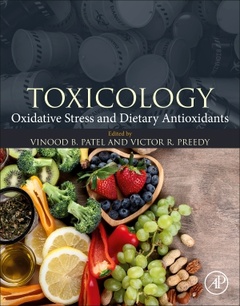Toxicology Oxidative Stress and Dietary Antioxidants
Coordonnateurs : Patel Vinood B., Preedy Victor R

PART 1 TOXICOLOGY AND OXIDATIVE STRESS AGRICULTURAL AND INDUSTRIAL CHEMICALS 1. Organophosphate pesticides toxicity, liver cells and linking oxidative stress 2. Organophosphate insecticide toxicity and linking oxidative stress 3. Organochlorine pesticide toxicity and linking oxidative stress 4. Paraquat and reactive oxygen species damage 5. Atrazine and oxidative stress 6. Fungicide and oxidative stress: a focus on Ziram 7. Dioxins and oxidative stress 8. Polyaromatic hydrocarbons 9. Oxidative stress and neonicotinoid insecticides METALS 10. Lead toxicity and linking oxidative stress 11. Cadmium toxicity and linking oxidative stress (author to link in human aspects) 12. Mercury toxicity and linking oxidative stress as indicated by malondialdehyde 13. Chromium toxicity and linking oxidative stress 14. Arsenic toxicity and linking oxidative damage 15. Rare earth element toxicity and genes in linking oxidative stress pathways DRUGS, FOOD DERIVED, CHEMICALS AND OTHER AGENTS 16. Asbestos fibers and oxidative stress 17. Anticancer agents and apoptotic cell death: linking antioxidant genes 18. Chlorine toxicity, oxidative stress and impact on isoprostanes 19. Ionic liquids as toxic agents and effects reactive oxygen species 20. 1,2-Dichloropropanetoxicity and reactive oxygen species 21. Aflatoxin B1 toxicity and the role of oxidative stress 22. Acetaminophen toxicity: the role of free radical mediated injury 23. Alcohol toxicity and the role of oxidative stress 24. Air pollution and pulmonary oxidative stress 25. Radiation and oxidative stress 26. Statins and oxidative stress with statins
PART 2 ANTIOXIDANTS AND TOXICOLOGY AGRICULTURAL AND INDUSTRIAL CHEMICALS 27. An overview of antioxidants 28. Garlic extract and protection in malathion induced damage: facets of oxidative stress 29. Laurocerasus officinalis roem. (cherry laurel) fruit and protection against organophosphate insecticides 30. Resveratrol and protection in malathion-induced oxidative stress METALS 31. Vitamin C and protection against arsenic 32. Fragaria ananassa and protection against cadmium toxicity 33. Citicoline as a nutraceutical and protection in metal poisoning 34. Acai fruit (Euterpe oleracea) and protection in mercury related oxidative stress 35. Antioxidant N-acetyl-l-cysteine in chromium protection 36. Nigella sativa seeds in lead related oxidative stress 37. Catechin and protection in cadmium toxicity 38. Kolaviron (KV) as an antioxidant: modelling arsenite toxicity DRUGS, FOOD DERIVED, CHEMICALS AND OTHER AGENTS 39. Moringa oleifera leaf extract and acetaminophen protection 40. All-trans-retinoic acid and protection against renal toxicant p-aminophenol 41. Rhus tripartita extracts and ethanol-induced toxicity: glutathione-S-transferases and beyond GENERAL ASPECTS 42. Antioxidants in Cynara scolymus and applications to toxicological sciences 43. Antioxidants in Crataegus Monogyna L flowers and applications to toxicological sciences 44. Nutrient based RiduROS and use in oxidant stress protection in radiation 45. Vernonia amygdalina (Del.) as an antioxidant in toxic injury
Victor R. Preedy BSc, PhD, DSc, FRSB, FRSPH, FRSC, FRCPath graduated with an Honours Degree in Biology and Physiology with Pharmacology. After gaining his University of London PhD, he received his Membership of the Royal College of Pathologists. He was later awarded his second doctorate (DSc), for his contribution to protein metabolism in health and disease. He is Professor of Clinical Biochemistry (Hon) at King’s College Hospital and Emeritus Professor of Nutritional Biochemistry at King’s College London. He has Honorary Professorships at the University of Hull, and the University of Suffolk. Professor Preedy was the Founding Director and then long-term Director of the Genomics Centre at King’s College London from 2006 to 2020. Professor Preedy has been awarded fellowships of the Royal Society of Biology, the Royal College of Pathologists, the Royal Society for the Promotion of Health, the Royal Institute of Public Health, the Royal Society for Public Health, the Royal Society of Chemistry and the Royal Society of Medicine. He carried out research when attached to the National Heart Hospital (part of Imperial College London), The School of Pharmacy (now part of University College London) and the MRC Centre at Northwick Park H
- Provides a novel collection of information linking both sides of redox biology (oxidants and antioxidants) and toxicology
- Explores the role of free radical mediated damage and toxicology
- Contains contributions from experts on toxicological science surrounding oxidative stress and on antioxidant approaches for reducing the impact of toxicant exposures
Date de parution : 11-2020
Ouvrage de 594 p.
21.4x27.6 cm


